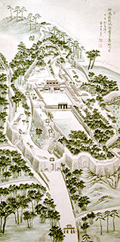As reforms continued, they brought with them a new and modern Okinawan culture.
In 1893 the first newspaper, The Ryukyu Shimpo, was started and soon many others began publishing as well. While these newspapers all competed for their own development and special interests, they fulfilled a vital role in the debates about government policy and brought new enlightening ways of thinking to the public.
In literature, 1904 saw a Ryukyuan culture and arts renaissance which included the expression of modern viewpoints by such men as Getsujo Iha and many others who wrote for various Japanese literary magazines. Seichu Yamashiro, who had exchanges with the famous poets Akiko and Tekkan Yosano, produced numerous works published within the mainland literary world. Others active in the Taisho period (1912-1926) include Kunio Serei and Sekiho Ikemiyagi and in the Showa period (1926-1988) there was Eikichi Yamazato and Nantestsu Iba. One of the better known of these was Baku Yamanoguchi, who went to Tokyo and lived as a starving artist to write witty poems full of humor and pathos.
In painting, the traditional arts patronized by the old court were preserved and developed but also there was a great influx of Japanese and Western art techniques . Shozan Nakazone, known as an official royal court painter and artist Kakoku Nagamine continued to paint in the traditional styles after the Meiji period began. They also incorporated the new techniques to create their own originality. Seiraku Nishime traveled to Tokyo Art School to learn the techniques of Western painting so that he and his fellow teacher Keijo Higa could pass these new techniques on to the younger generation of painters in Okinawa.
In music the traditional Okinawan music was categorized as Ryukyuan classical music and is the subject of study to this day. Choho Miyara introduced elements of Western music into these compositions and formed a new fusion with the classical Okinawan genre to create popular songs such as "Endo-no Hana" and "Nanta-hama". He was also a teacher of music at a teacher's school.
Performing arts for the public at large were began by those artists who had been schooled as performers for the royal court but had lost their employment when the court was dissolved. They were known as Shibaishi and through such plays as "Shurijo Hirakewatashi" and operas such as "Tumaiaka" gained reputations as public performers. The older forms of Ryukyuan theater arts such as Ryukyuan Classical Dance and Kumiodori (classical theater) were passed on to the younger performers but it is said there were few opportunities to play them before the public.

